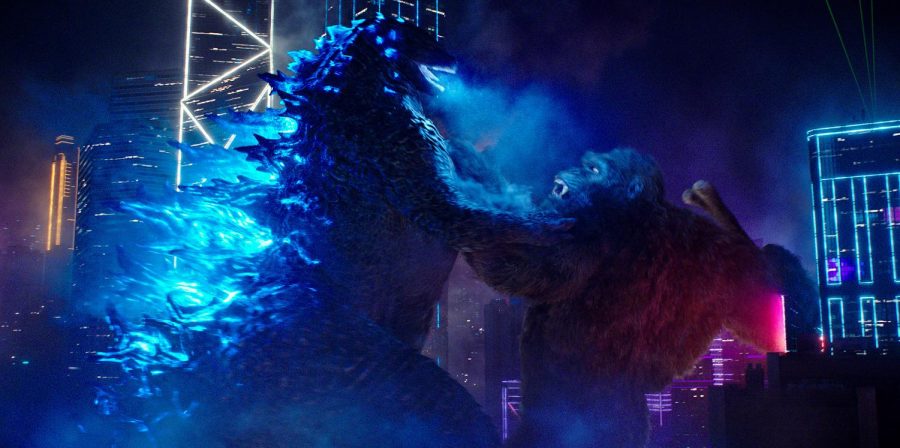“Godzilla vs. Kong” is the big action distraction we needed
Streaming recommendation of the week 4/9/21
The giant lizard and giant monkey face off in the most ambitious crossover event of the century.
April 9, 2021
The beautiful thing about movies is that it’s such a diverse medium. You can really tell a story about anything through the series of images spliced together that make up films. Sometimes, you want to see a film that challenges your perspective on the world, helps you process emotion and teaches you life lessons. Other times, you just want to watch a big lizard and a big monkey punch each other. There’s nothing wrong with that. Films can give many experiences and not all of them have to be high art. “Godzilla vs. Kong” is definitely not that, but it is also some of the most raw, dumb fun that has been condensed into a two-hour form in recent years.
In the seeming culmination of seven years of films, “Godzilla vs. Kong” is the latest film in Legendary Entertainment’s MonsterVerse. The series started in 2014 with the series reboot “Godzilla,” directed by Gareth Edwards, which was the second attempt by American filmmakers to completely adapt the Japanese property, following the disastrous 1998 “Godzilla.” In this new “Godzilla,” the film aimed to give the iconic monster a more grounded, gritty feel, while still embracing the giant action that comes along with Japanese monster—or kaiju—films. However, in a setup reminiscent of “Jaws,” we actually don’t see much of the titular monster throughout the film, with a band of human characters being the main focus instead until the payoff of a titanic final battle. The film was a success, and I personally enjoyed the restraint of the film throughout as it built anticipation for Godzilla’s grand appearance in all his glory, but many fans were left wanting for the monster action they were expecting.
“Godzilla: King of the Monsters,” the sequel to “Godzilla” released in 2019, seemed to hear that fan criticism loud and clear and made one of the loudest, dumbest, yet most visually stunning action films out there, with Godzilla facing three different kaiju as he battles for supremacy. Embracing the first film’s theme of Godzilla acting as an almost benevolent force of nature that strives to maintain balance, the monster seems to fight off the physical embodiments of climate change in non-stop action scenes that create some of the most striking and cheer-inducing setpieces this reviewer has seen. Who doesn’t want to see Godzilla roaring while the entire US military flies behind him as backup? Or Godzilla smoking another monster’s head with his atomic breath?
The monster action may have been much expanded on, but the sudden turn to camp seems to have come at the expense of the human characters. While the first film used its human characters to ground the film and contrast the massive size of the monsters and the impacts their presence would have on society, “King of Monsters” just uses them to set up a contrived plot. The characters often act simply as the embodiments of exposition, with corny one-liners and confusing plot turns. While the second film didn’t have the critical or commercial success of its predecessor, a cult following remained, with some fans arguing that the series should continue embracing the B movie roots of the characters.
Kong’s initial entry in the franchise, on the other hand, never had any pretenses about the type of movie it was. 2017’s “Kong: Skull Island,” directed by Jordan Vogt-Roberts, ditches most of the 1933 original’s colonial subtext and installs a quasi-Vietnam War allegory, with the entire film set in the 1970s and principal photography located in Vietnam. However, it doesn’t really go anywhere with the idea, using the theme to essentially steal some pretty iconic imagery from Vietnam movies like “Apocalypse Now,” and honestly I don’t really have a problem with it. It looks rad throughout and Kong smashes helicopters together after they do their “ride of the valkyries”-esque flights so it’s a win-win. There are many, many human characters, none of whom get much of an arc, but the film, again, mostly uses them for exposition and to give a scale to the monsters, and it helps that they aren’t too annoying. Altogether, the film makes up a visually stunning movie with a solid action-adventure vibe similar to an “Indiana Jones” film, with a solid balance between the action and the dramatic cheesiness inherent in the genre.
Now after all these years, “Godzilla vs. Kong” is here, debuting simultaneously on HBO Max and in theaters due to the ongoing pandemic. However in a time where more and more people are getting vaccinated and going out, it has arrived at the perfect time to break us out of our forced streaming existence. And boy, is there no better film to watch on the big silver screen.
“Godzilla vs. Kong” is escapism at its finest. Movies can be great at many things, and there’s nothing better than a film unafraid to embrace its own essence. While its been tiptoed around here and there, the previous films tried to at least keep some pretense of seriousness, inserting allegories of nuclear disaster, climate change, natural balance and war, but that’s all out the window here, and the movie is better for it. The film revels in its ability to make great actors say the stupidest lines imaginable with a lot of unintentional humor coming from the sheer awkwardness, but it’s all part of the fun—and when you can get Rebecca Hall to say lines like “Kong bows to no one,” or have Kyle Chandler say “Godzilla is hurting people and we don’t know why,” you are doing yourself a disservice if you can’t just go along with it.
The plot is nonsensical at best, with Godzilla attacking Apex Cybernetics, a human cybernetics corporation, because they are making mechanical monstrosity to replace him, all to make humans the “Apex” species once more. At the same time Kong is being coerced by humans into seeking out the power of the “Hollow Earth,” the tropical home of the original monsters set in the middle of the Earth (whose existence inadvertently set off an extended conversation between my friends and I about the existence of gravity in such a world and how scientific theory is never actually truth itself). None of it really matters, with the narrative being pretty streamlined compared to its predecessors. All of it serves only to set up a final fight in Hong Kong that takes up 30 whole minutes, in a visual feast of a finale. Similar to a theme park ride, the final act has its ups and downs, its moments of triumph and despair. I clapped, I cheered, I booed along with everyone else (in my case, just my group of friends inside a dorm room, though I definitely intend to see it once more in theaters once fully vaccinated).
What more can you ask for after a year of despair?



